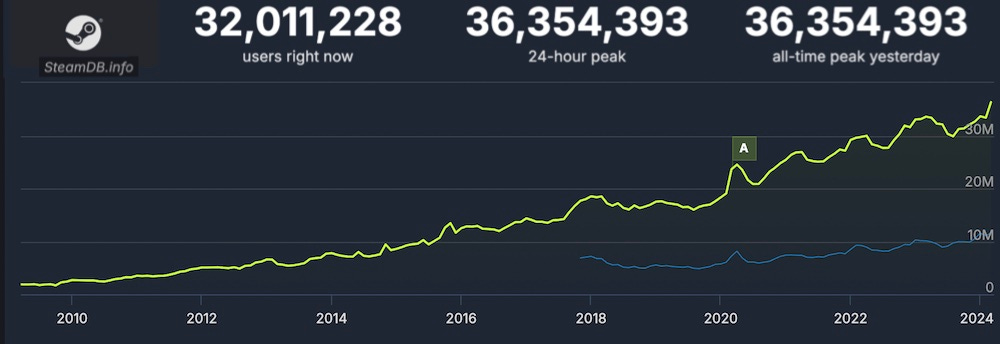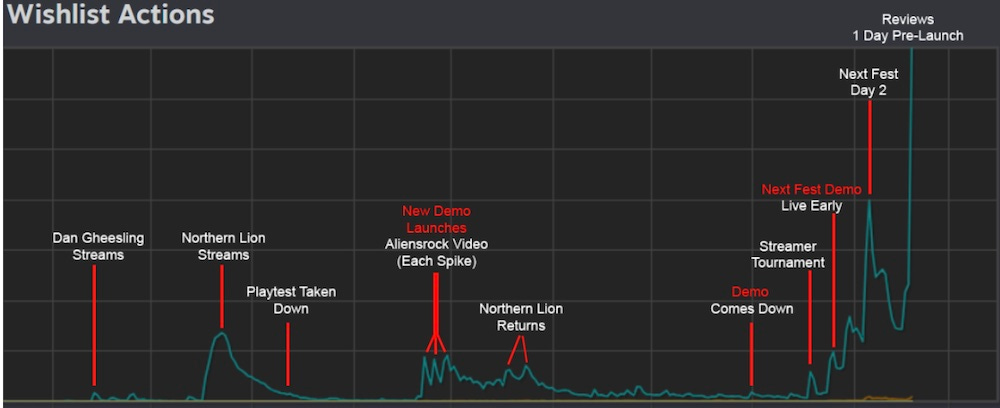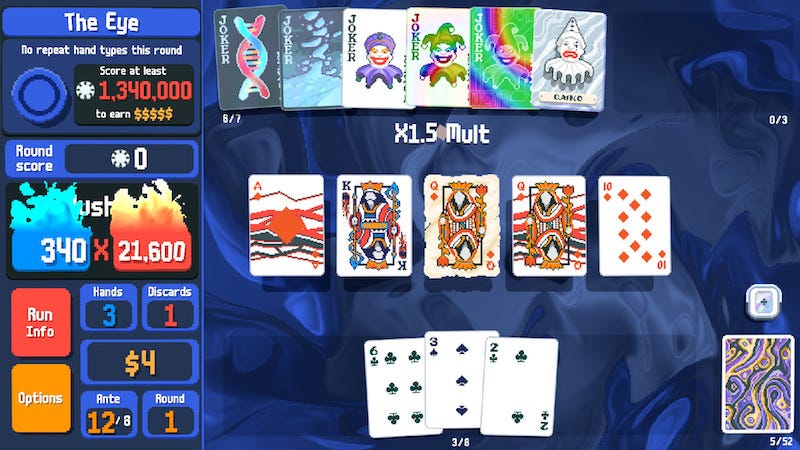How Balatro hit 1 million sales in less than a month!
We talk to the folks behind it. Also: lots of discovery news & some GDC bingo.
[The GameDiscoverCo game discovery newsletter is written by ‘how people find your game’ expert & company founder Simon Carless, and is a regular look at how people discover and buy video games in the 2020s.]
In ‘perfect timing’ news, LocalThunk & Playstack’s ‘poker-inspired roguelike deckbuilder’ Balatro just announced it hit 1 million units sold across PC and console (in <1 month!) Why perfect timing? Because it’s the subject of our lead story today….
Oh, and thanks to our inaugural newsletter sponsor, user-generated content distribution service mod.io - you’ll see their message today and Wednesday. Here’s info if you’d like to advertise, too…
[Also: yes, you can support GameDiscoverCo by subscribing to GDCo Plus now. You get full access to a super-detailed Steam data suite for unreleased & released games, weekly PC/console sales research, Discord access, seven detailed game discovery eBooks & lots more.]
Deep dive: how Balatro hit 1 million sales so fast
We presume you have a view on why people love roguelike deckbuilder Balatro. Our 2c? It’s the joyous diversity of joker strategies in each ‘run’! (Not the same subgenre, but reminds us of The Binding Of Isaac re: radically different player outcomes.)
And now the $15 title has officially sold a million, we reached out to publisher Playstack and solo, pseudonymous dev LocalThunk to get their comments on how this all went down. Firstly, let’s look at the pre-release Steam wishlist trends for the game:
As you can see, the game has thrived on both players - and big YouTubers - being able to play and share it, with big spikes around those times. We asked Playstack’s Liz Cheng-Moore about how the publisher played to the game’s strengths. She noted:
“In our initial marketing strategy, we decided that the best way to entice people with Balatro was to show people playing it. Pre-announce assets such as trailers, we suspected, were not going to be as effective. Accordingly, we identified three key marketing pillars to underpin our campaign: A playable demo, influencer engagement, and stirring a passionate community.
Firstly, playable: we focused a great deal of time on promoting the game through a custom demo. Extensive discussions were held to determine how to craft a miniature version of Balatro that encapsulates all its key elements including roguelike mechanics, synergy, and replayability.
We ultimately settled on a demo featuring a concise selection of features from the full game, with no round limit on play, enabling users to repeatedly experience a condensed version of the complete game. In the first three months following the demo release, we amassed 100k downloads on Steam.”
This makes a lot of sense! When the game is killer, you should carefully craft a demo and release it super early to get reach - especially among the key PC gaming crowd, for whom a card-based game is probably the most natural user interface.
GameDiscoverCo guesstimates PC sales are ~80% of that million sales, btw. And the devs gave us Steam country stats (to March 1st) headed by the U.S. (33%), China (26%), France (7%), Canada & the UK (4% each), Germany and Korea (3%), and Australia (2%).
Back to Liz, for notes on the other parts of the marketing: “For the second and third pillars, we decided to host a fun streamer tournament: Jimbo’s Invitational. We invited high-profile creators who have streamed Balatro to compete together in a bespoke tournament to find out who could achieve the highest score. The competitive nature of the tournament naturally encouraged creators to continue streaming for longer durations.
The 24-hour tournament attracted 5,600 peak viewers…. community engagement.. was significant, with members following the proceedings on Discord, sharing the latest scores, and discussing tactics. What enhanced [things] further was the participation of some streamers actively engaging with the community in Discord.”
Balatro’s gameplay win - not a lucky accident?
This was all extremely helpful. But we also wanted to know about that killer gameplay was formed. So we asked dev LocalThunk: “It's clear that Balatro has an INCREDIBLY strong game hook and also core game loop. How early did you realize this, and how long did it take to hone the gameplay mechanics?”
His fascinating initial reply on this was “I try to mostly focus on the flaws”, and he added:
Early on, the core loop of Balatro had dozens of interlocking mechanics and I knew that about half of them weren’t working, so you almost treat it like a pathfinding algorithm. Tweak or throw away the mechanics that aren’t working, test again, evaluate which aren’t working again, change them again, etc.
This iterative process is still happening and even today I mostly see the design of the game through the weakest elements.
As for the hook, you never really know until players get it into their hands. I haven’t experienced the hook, because this game has never been truly fresh for me. But I did realize it was a strength during each demo, and again during the first week of launch.
He concluded: “Using the 1 hour retention metric as a rubric for the ‘hook’ has been useful, and that number has improved as the game has evolved since the first public demo.”
One other tidbit we found fascinating? We asked LocalThunk about game balance and patching - which he is actively doing, btw. But interestingly, he is also fine with people sometimes ‘breaking’ the game, for possibility space reasons:
“The design of a game like Balatro is always being pulled in two directions: First, people need to be able to break a game like this in order to really experience the depth of it and see the gamut of what is possible. Second, if things are too unbalanced, then decisions become much less meaningful - because having a clear choice in a given situation is the same as having no choice at all, which is counter to fun.”
The overall result for Balatro is, we can assure you, not counter to fun. And to conclude, we asked the team behind it what they were most surprised by. Besides just ‘everybody talking about the game all the time’, hah, there’s one particularly offbeat ‘win’.
For the game’s creator LocalThunk, it’s the following: “That Balatro showed up as an official reference on the ‘Gros Michel’ Wikipedia page.” Yes, that’s… all kinds of bananas, isn’t it? *hook appears and pulls us offstage*
Launch in-game & cross-platform UGC with our sponsor: mod.io
mod.io offers a complete solution for user-generated content distribution; on any platform from PC, to consoles, mobile and VR. Plugins for Unreal and Unity, and a SDK for custom engines make implementation easy for all games.
Built as a white label solution, mod.io services allow you to create a fully tailored experience for your UGC creator community (in-game & web custom UI, SSO, moderation rules, real-time metrics); keeping your players engaged in your own ecosystem.
Reach out to discuss UGC implementation, or sign up to our newsletter covering our latest product updates, and industry trends.
Game discovery & game marketing - not the same!
We think indie dev Danny Weinbaum - who made lush 2019 3D ‘walking & painting’ game Eastshade with his wife and just published a YouTube video (650k views!) about how they did it - is a pretty smart cookie.
His studio is currently working on ‘story-driven witch academy RPG’ Songs Of Glimmerwick - currently at 87,000 Steam wishlists without demos or Next Fest appearances. And his latest YouTube video (above) is a bullseye for what we talk about.
Weinbaum says in the intro: “It seems that a lot of indies have this idea that discoverability is the only thing that stands in the way of their game being a top seller. They say to themselves: ‘Well, I know I can make a game - the problem is that I just don’t know how to market it.’”
And here’s the main takeaways we wanted to point out from his must-watch video:
The problem isn’t the marketing, it’s the product: Danny says - “It’s not that most indies fail to market their product, it’s that most indies fail to make a product that is marketable.” He suggests, in part, it can be because they haven’t done deep-dive, data led homework into the highest-demand genres and existing market comps.
Try to ignore the outliers - they’re not very replicable: as he notes: “we've all heard of games that look fairly unremarkable at first glance, but somehow manage to go viral anyway.” But, he says, it’s probably a fool’s errand to try to reliably reproduce a Vampire Survivors-like breakthrough - “it’s like lightning in a bottle”.
If you get the product right, marketing is like running downhill: "I cannot express to you how much easier marketing becomes when you have a product that interests people at first glance, and I cannot express to you how impossible marketing becomes when you have a product short of that."
His conclusion? “The games market is largely still rational, in that if you build something substantial it's likely you can compete - if your product can hang with the top of your genre on every level.” That’s not just gameplay, but also art, trailers, and hook.
So, what you’re looking to make is “a solid title, backed by ‘commercially serious’ production competency and effort, in a high demand genre on Steam.” And if you get all of that right, Danny thinks you have a higher chance of being rewarded.
We’re 100% on the same page about all of this. The only issue, in 2024, is that the financial reward for getting it ‘right’ is getting diluted, due to the sheer amount of games on all platforms. But them’s the breaks, huh?
The game platform & discovery news round-up…

Finishing up for today, we have a lot of neat discovery & platform news to cover. So let’s make like a boulder and roll:
As player interest in PC games increases, Valve’s PC platform Steam hit another new record over the weekend (above), per SteamDB, with 36.35 million users online - about 11.58 million of them actively playing a game. Impressive! (This is a very diverse global audience compared with console, btw.)
In a semi-surprising team-up, Amazon’s Luna cloud service and GOG.com have announced a collaboration: “On Luna you’ll be able to play every game that you already own on GOG (and that is also available on Luna)… You’ll be able to buy games that are available on GOG via Luna’s client and they will go straight into your GOG library.” Not all GOG games will be available on Luna - but this is intriguing.
How will U.S. game spending in 2024 turn out, at least from the sources Circana grabs data from? Mat Piscatella says: “Right now my most optimistic outlook is down about 2%… if you start looking a little bit on the more pessimistic side, you're looking at down about 10%”, or more. (Hogwarts Legacy is a giant-$ 2023 comp, btw.)
Bloomberg is reporting that “Sony Group Corp. has paused production of its PSVR2 headset until it clears a backlog of unsold units”, quoting un-named sources saying sales have “slowed progressively since its launch and stocks of the device are building up.” (The current price - $550 - and game selection may not be a great combo.)
Our ‘Epic vs. Steam’ lawsuit doc find got picked up widely & Ars Technica found the exact Aug. 2017 Tim Sweeney Tweets that prompted Gabe Newell's 'why you mad?' email - specifically: “Not sure why Steam is still taking 30% of gross. MasterCard and Visa charge 2-5% per transaction, and CDN bandwidth is around $0.002/GB.”
Briefly poking at the mobile market, Scopely confirmed a $2 billion gross for Monopoly Go on iOS/Android, up $1 billion in 3 months (!), also noting 10 million DAU, 8 million of which play daily (!!) Also notable: marketing spend of “less than a quarter of lifetime revenue” - so up to $500 million on >$1.4 billion (?) net revenue.
What’s up with Twitch streaming in Feb. 2024? According to StreamElements & Rainmaker.gg, “Twitch’s January and February daily [watched] hours stay above 2023’s”, which is good, and Helldivers 2 (#14) was the closest new game to cracking the Top 10 for most-watched games on Twitch.
Steam revealed the Top 100 Steam Deck games (by highest DAU) from March 2023 to March 2024. They’re topped by Baldur’s Gate 3, Vampire Survivors & DAVE The Diver, with ‘publisher’s games in top 100’ headed by: PlayStation (7 games), Capcom and Sega (6 games) and Bandai Namco, Bethesda, Electronic Arts, 2K, Warner Bros and Square Enix (4 games).
With surging coin prices, the Asian market’s still interested in blockchain games: mobile & PC F2P MMO Night Crows (which has a blockchain economy lurking in the background) is sporting 290k CCU right now, and the Philippines may be gearing up for Axie Infinity ‘play to earn’ craze Pt.2 - with different games. (Hm.)
“Making Steam capsule art is one of the hardest things to get right in game dev”, says a new YouTube video from Indie Dev Lab that handily explains the Steampoacher tool - “a simple tool for viewing and downloading the store and library image assets for any Steam game” - and the best ways to use it.
Esoteric microlinks: here’s the top Vtubers across Twitch & YouTube in February 2024; Sandbox VR’s Deadwood Valley experience - only available at its 45+ physical locations - has now grossed $40 million LTD; LinkedIn is working on in-app word & puzzle games, with “companies ranked by the score of their employees.”
Finally, ICO’s Thomas Bidaux has been making a GDC ‘bingo card’ for a few years now, and here’s his 2024 edition, which he freely admits is ‘The Depressing Edition’. Will your GDC conversations get you a bingo this year? Let’s find out:
[We’re GameDiscoverCo, an agency based around one simple issue: how do players find, buy and enjoy your PC or console game? We run the newsletter you’re reading, and provide consulting services for publishers, funds, and other smart game industry folks.]





I think you also missed the part about getting free publicity from having been delisted in some regions and systems. I personally didn't really know much about the game until every "nerd-news" organization got me interesting what Balatro was truly about through talking about the delistings